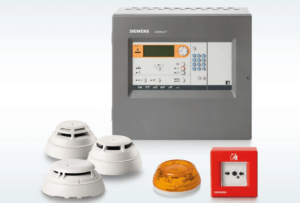When it comes to fire alarm systems, the choice between closed and open protocol can be a crucial decision that shapes the safety and security of a building.
Our service engineers are frequently asked what these terms mean, and how they impact fire safety measures and so we hope this article helps to explain their differences and implications.
Firstly, let’s explain each term:
Open protocol means that products are from manufacturers who will allow anybody to buy their software and to obtain spares.
Some manufacturers appoint approved distributors, like Tecserv UK, who are authorised to sell, install and maintain their systems. They do not make their software available to anybody, however by appointing approved distributors, buyers have a choice as to who they use for install and maintenance – this is known as Managed Protocol.
Finally there is a term known as a Closed Protocol, where the manufacturers themselves are the only ones who can use the software, therefore they are the only company that the end-user client can use for the ongoing maintenance of the systems.
Closed protocol fire alarm systems are akin to a fortress – tightly controlled and proprietary. In a closed protocol system, the components – including detectors, panels, and devices – are manufactured by a single supplier or a select group of approved vendors. This closed ecosystem offers a sense of security, as it ensures compatibility and uniformity across all system components.
However, the downside of closed protocol systems lies in their lack of flexibility and potential for vendor lock-in. Since components are proprietary, building owners and facility managers may find themselves beholden to a single supplier for maintenance, repairs, and upgrades. This monopolistic control can lead to inflated costs and limited choices, stifling innovation and adaptability in the long run.
At the other end of the spectrum, open protocol fire alarm systems embrace interoperability and diversity. In an open protocol system, components from various manufacturers are compatible and interchangeable, offering greater flexibility and choice to building owners and facility managers. This openness can help to foster competition, innovation, and cost-effectiveness in the marketplace.
However, the ‘open’ nature of these systems also introduces potential security risks. With multiple vendors contributing components, ensuring seamless integration and compatibility becomes a greater challenge. Moreover, the diverse array of components may vary in quality and reliability, raising concerns about system performance and consistency.
In the context of fire alarm systems, managed protocol typically refers to a standardised method or set of rules governing the communication between different components of the fire alarm system. This protocol ensures that various devices, such as smoke detectors, heat detectors, control panels, and annunciators, can effectively communicate with each other to detect, report, and respond to fire or other emergency situations.
Managed protocols are essential for ensuring the reliability, interoperability, and effectiveness of fire alarm systems. They define how information is transmitted, interpreted, and acted upon within the system, often incorporating features such as fault tolerance, redundancy, and prioritisation of alarms.

Compatibility: Closed protocol systems guarantee compatibility among components from the same manufacturer, while open protocol systems offer flexibility but may require careful selection and integration of components to ensure seamless operation.
Cost: Closed protocol systems may entail higher upfront costs due to proprietary components and vendor lock-in, whereas open protocol systems can sometimes offer more competitive pricing and long-term cost savings.
Innovation: Closed protocol systems may lag behind in terms of innovation and technological advancements due to limited competition, whereas open protocol systems foster innovation and drive industry progress through diverse vendor contributions.
Maintenance and Support: Closed protocol systems may offer streamlined maintenance and support from a single supplier, while open protocol systems require proactive management and coordination among multiple vendors for maintenance and troubleshooting.
Ultimately, the choice between closed, open and managed protocol fire alarm systems depends on factors such as budget, security requirements, flexibility, and long-term strategic goals.
Whilst closed protocol systems offer a sense of security and consistency, open protocol systems provide flexibility, choice, and potential cost savings, some believe ‘managed protocol’ offers a middle ground solution.
By understanding the differences and implications of each approach, building owners and facility managers can make informed decisions to ensure the safety and security of their premises.
If you would like to discuss changes to your fire alarm system please get in touch.

Colin joined Tecserv UK Ltd in 2010. He has been in the fire and security industry for 30 years + and in that time has held a number of senior positions. His experience helps to bring focus and growth to our sales and marketing strategy by being objective driven and KPI measured.